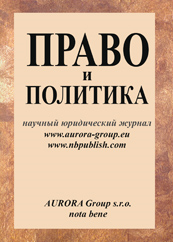Practical law manual
Reference:
Lobashchuk, V.E. (2025). The principle of publicity of the pledge of property rights: problems of law enforcement practice and legislative risks. Law and Politics, 5, 1–14. https://doi.org/10.7256/2454-0706.2025.5.74599
Abstract:
This article examines the issues related to the implementation of the principle of publicity concerning the pledge of property rights in modern Russian civil law (the subject of the study). The object of the study is the current legal regulation of the mechanism for ensuring the effect of «visibility» («publicity») of the pledge of property rights. The main objective of the study is to identify the shortcomings of the current mechanism for ensuring the effect of «visibility» («publicity») of collateral for property rights in order to further develop proposals to improve the accounting system for collateral encumbrances. The study examines in detail such aspects of the topic as the impact of the principle of publicity on the protection of the rights of participants in collateral legal relations and on ensuring the stability of civil turnover. Special attention is paid to the analysis of the existing mechanism for accounting for collateral encumbrances of property rights and the identification of systemic problems in the field of judicial and law enforcement practice. The methodological basis of the study is founded on the interconnected application of general scientific, specialized (comparative legal and formal-legal), and practical (comparison, description, modeling) research methods. The scientific novelty of the study lies in substantiating the necessity of transitioning from a declaratory to a constitutive model of registration of pledges of property rights, as well as in developing specific measures to reform the system of accounting for collateral encumbrances. During the research, systemic problems in the implementation of the principle of publicity regarding the pledge of property rights were identified, namely: the notarial registry contains incomplete information about all existing collateral relations, which is due to the legislator’s choice of a declaratory (confirmation) approach to the registration of pledges of property rights; the existence of «hidden pledges»; duplication of information across several disparate public registers; unreliability of entries about pledges of property rights due to the lack of verification of information when registering collateral encumbrances in the notary registry, etc. In conclusion, the study concludes that consistent reforms of the registration system are necessary in order to effectively ensure the principle of publicity of the pledge of property rights.
Keywords:
collateral creditor, hidden pledges, notary registry, constitutive registration, declaratory registration, opposability of the pledge, the principle of publicity of pledge, pledge of property rights, bona fide purchaser, Federal Resource
Theory
Reference:
Shaveko, N.A. (2025). Direct democracy as a normative ideal: a critical analysis. Law and Politics, 5, 15–28. https://doi.org/10.7256/2454-0706.2025.5.70187
Abstract:
The subject of the article is a normative analysis of direct democracy, namely, the identification of its advantages and disadvantages, the definition of the basic conditions and factors under which these advantages and disadvantages manifest themselves. To this end, the author lists the arguments "for" and "against" direct democracy, which are most often found in modern Western literature on this topic. The most popular classifications of voting types are given, and the advantages and disadvantages that are usually attributed by political theorists to each of these types are shown. At the same time, it is demonstrated that there is no agreement among researchers based on empirical data on many issues related to the influence of certain factors on the acceptability of the results of direct democracy, and therefore the final normative justification for the application of institutions of direct democracy is possible only in relation to specific institutions in specific circumstances. At the same time, the research is purely theoretical, not empirical. Empirical data are used exclusively to formulate theoretical generalizations, for example, regarding the procedure for initiating referendums and the binding force of decisions taken at a referendum. It is shown that it is possible to formulate a number of general recommendations that make it possible to actualize the positive consequences of direct democracy and avoid negative ones, namely: resorting to direct democracy, one should 1) correlate the scope of direct democracy with the civic culture of society; 2) evaluate factors such as the homogeneity of citizens' preferences, the personal interest of political representatives, the presence of influential groups lobbying for private interests, as well as the nature of the issue (technical or not) and the availability of information; 3) maximize the use of advisory mechanisms at the stage preceding the direct expression of the will of the people; 4) competently integrate the institutions of direct democracy into the existing system of checks and balances; 5) give priority to bottom-up votes 6) if possible, make decisions taken at the polls binding.
Keywords:
voting, participatory democracy, deliberation, deliberative polls, accountability, populism, legitimacy, democratic theory, referendum, direct democracy
XXI century International law
Reference:
Belkin, D.S. (2025). International legal regulation of migration in the context of international construction contract law. Law and Politics, 5, 29–51. https://doi.org/10.7256/2454-0706.2025.5.74469
Read the article
First Peer Review:
Second Peer Review:
Third Peer Review:
|
EDN: UFUVMM

|
Abstract:
In the article, the results of the conducted research are reflected, revealing the public international law framework governing labor migration in global construction projects. Subject matter encompasses the interplay between International Labour Organization Conventions No. 97 and No. 143, the 1990 UN Migrant Workers Convention, European Union Directive 96/71/EC, bilateral investment treaties and soft-law instruments, all examined through the specific prism of construction contract practice. The study identifies institutional fragmentation created by tensions between states’ police powers to regulate entry and the freedom to provide services, a gap that exposes migrant builders to heightened exploitation risk in jurisdictions with weak judicial capacity. A comparative doctrinal analysis of treaty provisions, European Court of Human Rights precedents, Court of Justice of the European Union case-law and recent ICSID awards is combined with empirical scrutiny of corporate codes and lender safeguard policies. Findings demonstrate that effective protection requires harmonising core obligations via protocol amendments to ILO conventions, expansion of Directive 96/71/EC to cover recruitment fees and joint liability of contractors, and integration of fair recruitment standards into FIDIC-based contracts. The article proposes establishing an ILO registry of bilateral agreements with consultative monitoring and issuing global guidelines on minimum labour conditions for the construction sector, thereby enhancing legal predictability for investors while strengthening human-rights compliance. These recommendations contribute a coherent model that bridges public and private international law and align migration governance with Sustainable Development Goal 8 on decent work.
Keywords:
international construction contract law, national legislation, sustainable development, international standards, unification of legal norms, ICCL, migration, legal protection of migrants, labor migrants, international cooperation
Practical law manual
Reference:
Grigor'ev, I.V., Kushnarev, A.S., Stepanov, K.A. (2025). Protection of feelings, emotions, and experiences in disputes with the Social Fund of Russia on compensation for moral damage. Law and Politics, 5, 52–64. https://doi.org/10.7256/2454-0706.2025.5.71071
Read the article
First Peer Review:
Second Peer Review:
Third Peer Review:
|
EDN: ULKAKM

|
Abstract:
Compensation for moral damage is the main way to protect intangible benefits and personal non-property rights of citizens. In this paper, the authors investigate the totality of the norms of civil legislation governing the grounds and procedure for compensation for moral damage. Special attention is paid to the author's approaches to the sample under consideration. As you know, the content of moral harm is certain negative feelings, experiences, emotions that are reflected in the human mind. In this connection, there is a legal uncertainty: are feelings the subject of proof of a violated right or a separate benefit protected by law that may be harmed? As a methodology, the authors use comparative approaches to compensation for moral damage for violations of property rights in the practice of the Supreme Court of the Russian Federation and the Constitutional Court of the Russian Federation. The authors cite the point of view according to which feelings are a separate good that can be harmed, in connection with which the need for an independent tort is actualized. To support the author's position, an example is the Ruling of the Constitutional Court of the Russian Federation, in which the Court focuses only on the harm to the dignity of the individual caused as a result of violation of non-property property rights, completely ignoring the intangible benefits in the form of feelings, which were also damaged. The authors disagree with the position of the Constitutional Court and formulate their position, according to which harming a person's feelings, emotions and experiences as a result of violation of his property rights is an independent tort, in connection with which a citizen can file a separate claim for compensation for moral damage caused to his feelings, emotions and experiences.
Keywords:
tort, independent benefit, subject of proof, feeling, emotions, experiences, moral harm, compensation for moral harm, social security law, civil law
Jurisprudence
Reference:
Padyukin, I.V. (2025). The concept and types of real estate property for religious purposes of the Russian Orthodox Church. Law and Politics, 5, 65–79. https://doi.org/10.7256/2454-0706.2025.5.74323
Abstract:
Questions regarding the legal regime of immovable property objects designated for religious purposes by the Russian Orthodox Church are among the most relevant issues in both church law and civil law sciences, which underscores the necessity for a comprehensive theoretical and practical understanding of the social relations concerning such objects. One of the significant problems that define the complexity of regulating the property relations of religious organizations is the uncertainty of legislative terminology. The aim of this article is to identify the relationship between the concepts of "property for religious purposes," "property for worship purposes," and "cult property" within the legal relations of the Russian Orthodox Church regarding immovable property. The object of the study is the property relations of the Russian Orthodox Church and its canonical subdivisions, registered as legal entities concerning immovable property. The subject of the research is the norms of current Russian legislation regulating the property relations of religious organizations. By applying general scientific methods (analysis, synthesis, induction, deduction, analogy, etc.) and special legal methods (formal-legal and comparative-legal), the author concludes that it is impossible to define the identified property categories without considering the internal regulations of the Russian Orthodox Church, as well as an appropriate level of church law culture. The article analyzes the aforementioned concepts and defines their interrelation; it reveals the characteristics that allow attributing particular immovable objects to the identified groups; and it formulates a definition of the concept "property for worship purposes." By applying general scientific methods (analysis, synthesis, induction, deduction, analogy, etc.) and special legal methods (formal-legal and comparative-legal), the author arrives at the conclusion that it is impossible to determine the identified property categories without taking into account the internal regulations of the Russian Orthodox Church, as well as a proper level of church law culture. The cult nature of the religious property dictates its special legal regime, which necessitates specific legal regulation of property relations.
Keywords:
religious organizations, property law, practical theology, church-state relations, canon law, cult property, property for liturgical purposes, property for religious purposes, Russian Orthodox Church, sacred property
 This work is licensed under a Creative Commons Attribution-NonCommercial 4.0 International License.
This work is licensed under a Creative Commons Attribution-NonCommercial 4.0 International License.
 Eng
Eng











 © 1998 – 2025 Nota Bene. Publishing Technologies. NB-Media Ltd.
© 1998 – 2025 Nota Bene. Publishing Technologies. NB-Media Ltd.




